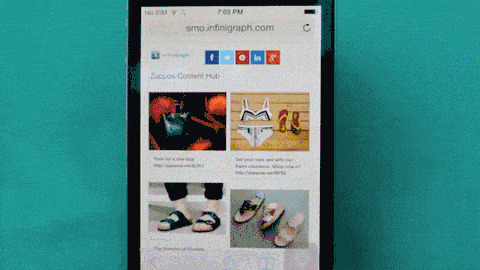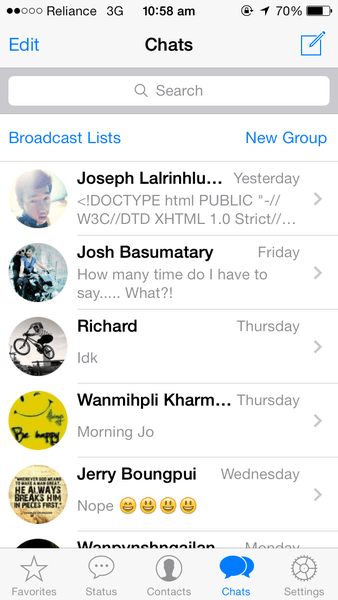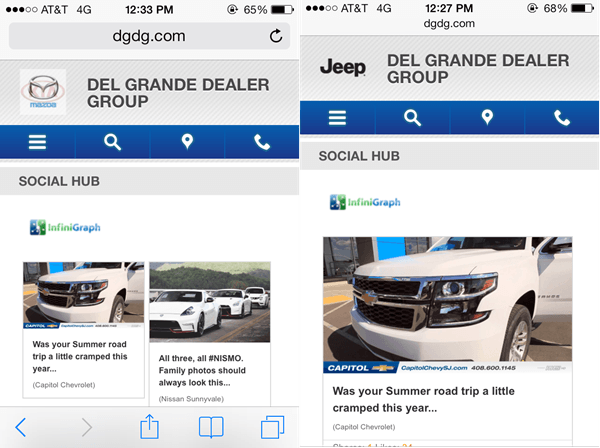The world has gone mobile in a big way and brands are using growth hacking techniques to reach those “on the go” consumers via content marketing and native advertising. According to a recent study released by comScore, mobile app consumers see more digital content than desktop or mobile web surfers, accounting for 52 percent of the time spent using some type of digital media.
Combine that with mobile web, and it accounts for 60 percent of time spent on a small screen.
Social networks and publishers have embraced instream and on-page native advertising. They are using it to drive content amplification, and for good reason. Here, I will address five mobile tactics any brand can implement to take on mobile in a big way.
 Video capture of an iPhone displaying native content insertion with responsive design.
Video capture of an iPhone displaying native content insertion with responsive design.Photo: Created by Chase McMichael
The displayed media world is seeing a continuous decline in ad effectiveness. At the same time, brands are demanding more reach and conversions from their mobile consumers. In a previous post, I addressed the steps brands can take to enhance their social intercourse between native advertising and content marketing. Now, lets look at a few more ways to get the most out of your content marketing efforts.
Brands Must Think Big
It all starts with thinking big. The big data and behavioral intelligence grab is happening at a staggering pace and it’s a very big deal.
Facebook bet on WhatsApp – and it is no joke at $16 Billion. They also forced their own messaging app on Facebook users. Why is this relevant to content marketers and brands?
Because he who owns messaging, and therefore what’s in everyone’s hand, also controls the distribution and the data. Controlling your data means access to what you’re doing, where you are, who you are messaging, what you’re interacting with, and who you’re interacting with.
It’s worth billions in advertising insight.
 WhatsApp Main Messaging Screen
WhatsApp Main Messaging ScreenSo what does the advertiser do about native advertising and content marketing in such a controlled environment?
It is all about being in the stream and getting to be part of the conversation. Getting consumers dependent on their content streams and then controlling their ability to chat with their connections is not by accident, but by design.
Facebook, with 1.9 billion users, might say they have won the “instant messaging” race, but not so fast – if we can learn anything from the past, it is that forcing single messaging standards is not sustainable.
There has been lots of chatter and discontent from users being forced to use Facebook messenger and the egregious Terms of Service. It kind of makes you feel like you’re in the movie “1984”.
Recently several acquaintances sounded off about the Facebook chat app: Frank Eliason – “To me I should not be required to have yet another app. It is a bad user experience to force that. Due to this I refuse to download it.”
This statement by Robert Scoble sounds more like “resistance is futile”: “Messenger is — by far — the best way to chat with me and others and that means you will all be on Messenger soon. Most of my 5,000 friends have already gotten Messenger, by the way. I remember more than a million people who protested the news feed when that was brought out. We hate change. Get over it. The sooner you do, the better your life will be.”
Brands must think beyond the campaign, because consumers are engaging 24/7, in real-time, across many devices. Embrace proven publisher techniques that do not require a website rework.
Remember, we’re at the tipping point – mobile and native ads in the stream are winners. Your content has to be stream friendly and it has to have a mobile-centric path to purchase.
 Facebook messenger popup to download app Photo/ Screen shot 08/23/2014 www.facebook.com
Facebook messenger popup to download app Photo/ Screen shot 08/23/2014 www.facebook.comA recent report by Nielsen’s The Mobile Tipping Point, Best Practices for Accelerating Mobile Brand Advertising Growth summarizes a survey about agencies, brand marketers, and media sellers. The report suggested:
- 70 percent of advertisers would increase use of mobile advertising if they could measure audience reach and ROI
- Three-quarters of new mobile funds will come at the expense of other online and offline budgets
- One-fifth of advertisers will increase their mobile spend by more than 20 percent in 2014
- Spending on mobile brand initiatives will grow faster than spending on direct response initiatives in 2014
- Advertisers most desire gross rating points – GRPs – to measure audience reach and brand lift to measure ROI
The key to great native advertising is integrating the right content within context of where the native ad is being shown. Unfortunately, this runs against what most of us are used to in the display world.
Some call native advertising deceptive. I just think it is smart placement with greater relevance, especially in the mobile environment.
Here we will go over the 5 leading tactics that are driving this big change and what you can do to prepare for battle.
5 Mobile Content Marketing Techniques
1. Mobile
Do some analysis on your own web site and other consumer touch points. Use a web site tracking tool to find basic numbers on your customer’s mobile behavior. I use Google Analytics, however most tools let you filter down to mobile-only interactions. Brands who are using social as an amplification method most likely already know their mobile traffic from these social platforms have drastically increased.
Here are a few tip to consider:
- Compare your bounce rates on desktop vs. mobile. Is it high?
- See how deep your consumers go on mobile within your site.
- Pick out your top five competitors and click on their posts on your mobile device
- Get your company involved and get feedback on your mobile experience.
There is a ton of mobile native applications on the market and most only offer simple notifications. Most apps see a high opt-out rates on mobile push and many consumers have too many apps with too many notifications. The point is, there’s a good chance you’ll get ignored.
Be realistic about your approach. It is highly possible that having a mobile optimized content experience is a better direction over a native app.

ComScore recently did an analysis on the top mobile apps, and most of you reading this probably have one or more of them on your device right now. These are the apps that, as a brand, you are inadvertently competing against. This is why adding your voice to the feed is so critical.
Be honest, who has downloaded the Geico app to take care of a car accident or Comcast app to “Improve” customer service? If you have used any of these apps please comment. I’d be interested in your opinion of their effectiveness.
 Top 25 Mobile Apps by Unique Visitors (000) based on comScore Mobile Metrix
Top 25 Mobile Apps by Unique Visitors (000) based on comScore Mobile MetrixPhoto: Created by Chase McMichael
Some apps are like wearable devices. You try them out with lots of enthusiasm, but find you are less and less excited about using them over time because they didn’t fundamentally change your behavior. The notifications get forgotten and just take up space on your device. A more comprehensive approach on what you should consider for a brand app strategy vs. mobile web can be found here: How to decide between a responsive website or a native mobile app.
2. Content Personalization
Content personalization is a big buzz word, along with predictive intelligence. The real question is — Is your content accessible and smart? First off, lets discuss what personalization is. In the world of mobile, displaying content relevant to the customer based on behavioral data and insights has proven to increase engagement and conversion.
What steps are you taking to make your content intelligent to increase your customer interactions?
 Making content personalized only improves the user experience
Making content personalized only improves the user experiencePhoto: Creative Commons
Using ad exchanges or Google ad retargeting is the poor man’s approach to personalization. Yes, advertising is content, yet most brands don’t do anything on their own sites. Marketing automation vendors, email platforms, and some content recommendation companies have started to personalize content based on:
- Return customers based on cookies or other tracking
- Prior history of purchases
- Friends purchase history
- Browsing history
- Surveys they may have filled out
- Search behavior
- Data from a customer profile
There is even a move to use predictive algorithms to infer what a consumer would buy or what content is most appealing based on past engagement, however, this is still slow in coming. The ad tech companies and publishers were the first to mass personalize content in real-time using retargeting of ads. You will see these retargeted ads show up in the standard ad placement areas.
Companies like Amazon and Home Depot will display the actual item you were looking at within a sponsored post on Facebook or other sites. The infrastructure to support this type of personalization is well established, but most of you coming back to a brand’s site don’t see anything.
If your customers are accessing your site via mobile there’s a great opportunity to display this “personalized content”. Retargeting on your own domain has great benefits and could be a much simpler approach to increase yield while you gear up for full-site personalization.
3. Native Insertion
Making content “stream ready” and optimizing your landing pages to be mobile friendly is not an option, but a must have. The ability to insert content that’s mobile designed is key to adapting to the mobile experience. Brands must think beyond just mobile optimized content to what content the consumer will actually engage with. The goal of content insertion is to transform a dead site into a dynamic and engaging one.
 Live example of Mobile Native content insertion.
Live example of Mobile Native content insertion.Screenshot taken 09/02/2014 www.dgdg.com
Take the time to open up a mobile browser, and see how well your website performs. If you’re not getting people to scroll and click, then you have failed. If they have to zoom in to see your small tabs or they are reading super small text you have lost them and they will bounce. Images on mobile are worth a 1000 words. Just be careful, for every ¼ second, you can lose a 1000 people.
- Keep advertising in context to what’s being displayed on your entry page. Assure your mobile native ads, and the images used in the ads, are on the landing page to lower your bounce rate.
- Identify other content that’s related or relevant to the entry image and make sure it is accessible.
- Doing mobile lead capture is hard – who wants to fill out a form on mobile? Don’t require info you can get off the web or from a data broker (don’t be lazy).
- After a purchase or registration leverage native insertion to recommend content like what’s trending on your brand. Don’t show a bland “Thank you” message.
Below is an example of a Mott’s mobile optimized, native ad unit inserted within a blog post. Content is dynamically arranged based on where they are coming from. Your customers are going to experience your brand via an email notification, social share in their feed, or a purchased native ad.
 Example of native insertion that’s mobile optimized supporting responsive design.
Example of native insertion that’s mobile optimized supporting responsive design.Screenshot 08/25/2014 www.socialmoms.com
Deciding what channel is going to yield the highest quality is based on the quality of the site you’re promoting on. The social feeds have become cluttered because everyone is rushing to be in the feed.
Here are some known, and not so well-known, networks to consider:
- SocialMoms: Native ad network and content creation
- Yahoo Gemini: Native ad network
- Pinterest: Promoted pins
- Facebook: Sponsored posts
- Twitter: Promoted tweets
- Sharethrough: Native to the other web
- BuzzFeed: Amplification and native
4. Mobile Search SEO
A recent study back in March of this year suggests that mobile will drive 50% of Google’s paid search clicks by 2015. Marketers have steadily integrated many campaigns with mobile targeting into advertiser’s campaigns. Just last year 19% of Google’s ad revenue came from mobile search ads, and it’s expected to rise to 30 percent over the next 3 years, according to eMarketer. SEO has always been content-driven, however, site optimized versus personalized content has changed greatly over the past few years.
For most user-experience designers it’s not surprising to see sites converting what they have on the web to mobile and calling it done. This is a major mistake. You should strive for an experience tailored for mobile.
We are now in a new phase of content development where in-app and mobile web experiences are converging. Mobile content engineering should be a job title and we’ll be seeing a great deal of change in this area in the near future.
Content is being developed and engineered for device types and it’s changing the way consumers interact with content in ways we’ve never thought of. To prepare for your mobile content revolution here are some points to consider:
- Accessibility Via Mobile Device: If your site offers a poor user experience, your customer won’t stay on your site. Even worse, your mobile search ranking could be lowered due to poor engineering.
- How you configure your site: Not all mobile solutions are the same, and many package’s mobile configurations can cause you major problems for search engines and be a nightmare to implement.
- Desktop Vs. Mobile: SEO still applies but it’s no longer long form. Your mobile users will have different needs. Make sure you have determined why consumers would access a mobile page and, if by mobile search, via what key words.
Remember, images are powerful and having an adaptive design lets your customers access what they want faster.
5. Data and Tag Management
Are you collecting the right data from your consumer touch points? Can you identify customers across each channel and follow their activity within specific target categories? Brands must have a clear strategy toward tag management and be able to track events to map the customer journey.
Data is not spandex, and one size doesn’t fit all. Identify which partners are helping you with data capture and process it efficiently and effectively.
 Tag management and data layer process
Tag management and data layer processPhoto created by Chase McMichael
Whether you are using a native app or mobile web site, having well-defined containers is a must have. As marketers, we can use mobile behavior analysis and cross-channel activity monitoring to create actionable data. Brands will have to have new competence in multiple organizations in this ever-changing landscape.
Converting Passion Into Mobile Action
Regardless of what devices or access points your consumers engage on, your ability to select strategic areas to insert the right images are changes what your customers will engage with. Before your customers even start to read they look. What’s in the image? The color combination and relevance are all factors on getting your content shared and clicked.Investigating how to leverage on domain and off domain native content insertion will only improve your mobile content marketing strategy.
Most brands are committed to building highly customer-centric, marketing focused, and good cross-channel experiences. The big challenge is driving a repeatable marketing ROI over each channel. The brands that master this will have invested in the right high-growth areas such as multi-channel/multi-screen marketing and coordination.
What steps and big investments are you planning for mobile content delivery in 2015?
Featured Image: Jhaymes via Flickr (Creative Commons)





![AI Overviews: We Reverse-Engineered Them So You Don't Have To [+ What You Need To Do Next]](https://www.searchenginejournal.com/wp-content/uploads/2025/04/sidebar1x-455.png)